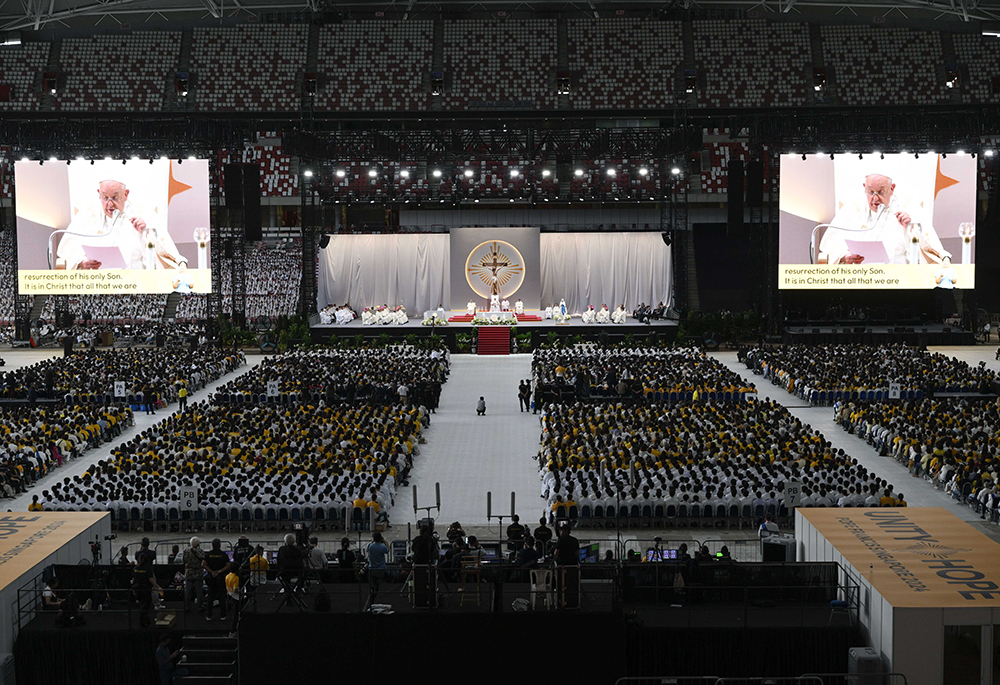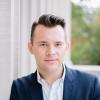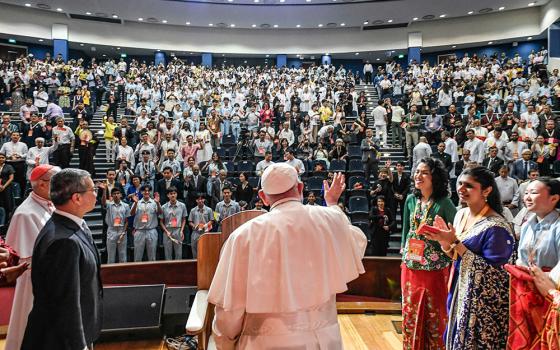
Faithful wait in the Singapore SportsHub National Stadium where Pope Francis will preside over a Mass "In Memory of the Most Holy Name of Mary" celebrated by the archbishop of Singapore, Cardinal William Goh Seng Chye, center right, Thursday, Sept. 12. Pope Francis has praised Singapore's economic development as a testament to human ingenuity. But he is urging the city-state to look after the weakest too. Francis made the remarks Thursday on the final leg of the longest and farthest tour of his papacy. (AP photo/Gregorio Borgia)
As Pope Francis on Sept. 12 celebrated a Mass in one of Asia's thriving metropolises — encouraging the small Singaporean Christian community in its "constructive dialogue" with other traditions — the closely watched papal visit here is fueling hopes he might continue to break down barriers in other places on the continent where Catholicism has been met with resistance.
"I hope that someday soon the pope can visit China," said Wang Yen, who is originally from Harbin, China, but who has lived here the last nine years.
Yen attended the papal Mass with fellow parishioner Sidney Kwok, who moved to Singapore from Hong Kong some 30 years ago.
"History plays a part in the Chinese government not allowing Catholicism or other religions to flourish in mainland China," said Kwok ahead of the Mass.
"Some religious groups have triggered uncertainty in China, so the central government is very careful about religious groups, not just Catholics," Kwok explained. But after a visit to mainland China this past June where he met with three bishops, he believes the situation for Chinese Catholics is improving.
Throughout Francis' nearly two-week, four-country tour through Asia and Oceania, the pope has repeatedly insisted on his desire for the Catholic Church to be more missionary and more focused on its peripheries. As this ambitious journey winds down — he is due to return to Rome on Sept. 13 — his final stop here in Singapore has only further underscored Catholicism's pivot to Asia under his papacy and heightened aspirations that the trend will continue.
While China and the Holy See do not have official diplomatic relations — and no pope has ever visited the world's second most populous country — China has loomed large over this leg of the journey.
Not only do China and Singapore have strong geopolitical ties, but about 75% of the population here is ethnic Chinese. Meanwhile, a recent thawing in Vatican-Chinese relations has led to a landmark, though controversial, 2018 agreement regarding the appointment of Catholic bishops in the country, but prompted a number of questions as to whether the church is being forced to remain silent in the face of human rights abuses and threats to religious freedom.

An estimated 50,000 people gathered for Mass with Pope Francis at Singapore's National Stadium Sept. 12. (CNS/Vatican Media)
For Yen, who is 35, the pope's visit sends a message to her Catholic family members back home that they have not been forgotten.
Despite the tempestuous relationship between one of the world's superpowers and the world's smallest state, both Yen and Kwok say they are "of course" supportive of the Vatican-China agreement and hope it is extended for a third time when it is up for renewal next month, especially for the sake of younger Catholics.
They maintain that freedom to worship is not restricted in the country, but that the Chinese government is moving cautiously because they want to unify all religious groups to follow its policies.
"The Chinese government is very difficult to predict," said Yen. "But the central government is becoming more receptive."
Yet here in Singapore's National Stadium — where some 50,000 Catholics had turned out for the papal Mass — it wasn't just Chinese Catholics eager to cheer on the pope's focus on Asia and dream of potential papal visits to their own respective homelands.
"I hope in the near future he is coming to visit," said Vu Hgoc Minh Tuyen, who traveled here with some 500 Catholics from Vietnam.
Those hopes are not entirely far-fetched.
Earlier this year, the Vatican's foreign minister, Archbishop Paul Gallagher, visited Vietnam, intensifying speculation about a first-ever papal visit to the communist country. Last year, when Francis became the first pope to ever visit Mongolia, he was asked if Vietnam was on his travel agenda.
Advertisement
"If not me, then surely John XXIV!" will visit, the pope said, using a hypothetical name for his successor.
Also in the audience at the papal Mass was Jasmine Tjai who traveled to Singapore from neighboring Malaysia — home to less than 5% Catholics and where no pope has ever even been invited.
"For my country, my church is quite small," she said. "I am here today to get closer to him, otherwise I would never see him."
"It's very difficult because of the politics," she explained, "but of course I would like him to visit us."
As Francis celebrated the final Mass of his tour, he lauded the diversity of both the church and the country — all of which were on display during the liturgy that included the four official languages of Singapore: English, Malay, Mandarin and Tamil.
From the altar, the pope could glimpse the city's imposing skyscrapers where he recalled the example of past missionaries, such as the Jesuit St. Francis Xavier, who had evangelized the region some 500 years ago.
And seated in front of the missionary pope, some enthusiastic Massgoers were hoping and praying that Francis himself continues in those same pioneering footsteps in their own native lands.
For now, however, they were just grateful that the nearly 88-year-old pontiff had made the taxing journey to be with them here, arguably making him one of the stadium's highest profile visitors this year — second only to Taylor Swift.







